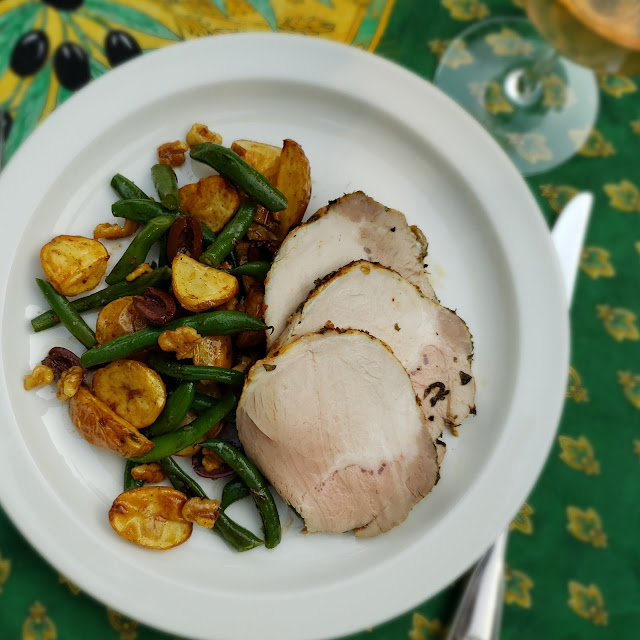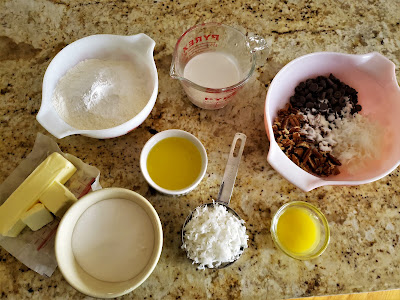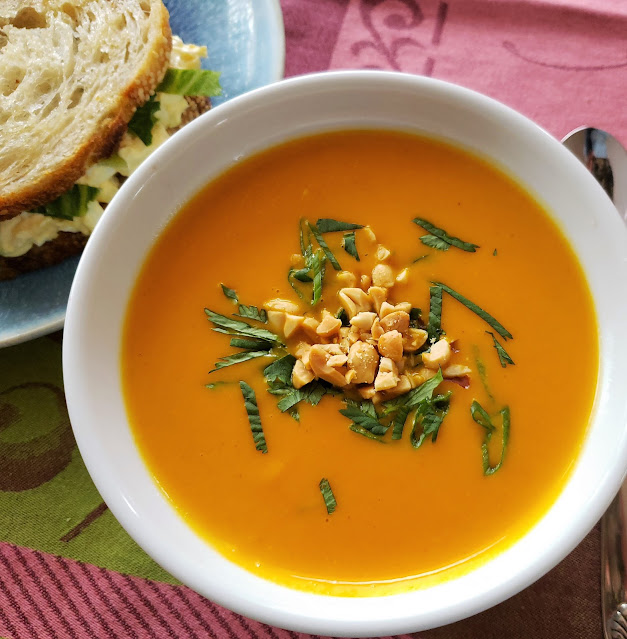In the early days of the pandemic
I started doing curb side pick up dinners. It was a good option for people who wanted to "eat out", but didn’t want to eat
in a restaurant filled with people. The dinners were 3 courses and packaged with instructions for any last minute heating/dressing/etc. I enjoyed the change of pace…as well as the additional work…so have continued to do them occasionally—even though there is no longer the same “need” for them.
Just as with my private dinner menus I’m sure it comes as no surprise that my menus for these dinners always highlight seasonal ingredients. I usually start with an idea for one course and then create the remaining two courses around it. For the recent September dinner I started with the idea of
Applesauce cake. It is still warm where I live so I opted for a room temperature roast pork with green bean and potato “salad” for the entrée.
This meant I didn’t really want to do a true salad for the first course (it seems repetitive to have a salad in 2 of 3 courses…). Since the dessert was cake, a tart or pizza seemed like a good starter.
As I considered my seasonal options, corn and zucchini…and tomato!...came to mind. These things are at the end of their season. I always feel a nostalgic desire to eat lots of the waning fruits of the season—even as I look forward to the new crops coming in. (The “cusp” seasons are always exciting moments in the culinary year.)
There are a lot of component parts to this galette. If you just want to make dinner, it will seem a bit fiddly. But it is actually pretty easy to put together once you have the components (all of which can be made ahead except for the salted squash)—making it perfect for entertaining. If you have your own favorite tomato sauce on hand, you can use it as long as it is very thick (cook it down a bit until it no longer weeps and it mounds on a spoon). You will need about 3/4 cup. The one I use here is
my favorite summer tomato sauce—nothing more than vibrant, vine ripened tomatoes (skin, seeds and pulp) cooked down with a generous amount of garlic, pepper flakes and olive oil. You could likely omit the ricotta—the thick tomato sauce providing enough of a barrier to keep the crust from becoming soggy—but I like the richness that it adds. (If you were to omit the ricotta, I would probably increase the Gruyère a bit.) The tomato sauce, on the other hand, should not be skipped. Its tartness adds essential balance and interest to the other mild flavors.
The tart made a great first course for my curbside dinner—a wonderful addition to the end-of-summer theme. I enjoyed the leftovers for lunch…and then a light dinner…along with a nice green salad. I’m only sorry that the season for these vegetables is rapidly coming to a close and it will probably be next year before I make this vibrant tart again. Maybe you will find a way to squeeze it in this year.
Late Summer Zucchini & Corn Galette with Tomato & Browned Butter Breadcrumbs
175 g. all purpose flour (about 1 1/3 c.)
1/2 t. salt
132 g. cold butter (about 9 T.)
50 to 66 g. water (about 3 1/2 to 4 1/2 T)
Combine the flour and the salt in a medium-sized bowl. Rub/cut the butter into the flour until the mixture has the appearance of cornmeal and peas. Drizzle 3 1/2 T. ice water over the flour/butter mixture. Using your hands, fluff the mixture until it begins to clump (if you grab a handful and squeeze it will adhere), adding more water if necessary. Turn the dough out onto a counter and form into a mound. Using the heel of your hand, gradually push all of the dough away from you in short forward strokes, flattening out the lumps. Continue until all of the dough is flat. Using a bench scraper, scrape the dough off the counter, forming it into a single clump as you do. Form the finished dough into a thick disk. Chill for at least 30 minutes (overnight is even better, if you have time).
To roll out the dough, let it warm up for a moment or two at room temperature. Line a baking sheet (preferably rimless) with parchment paper; set aside. Roll out the dough on a lightly floured surface into a circle that is about 1/8-inch thick and is 14 inches across. Brush off the excess flour. Trim any ragged or uneven edges if you like. Transfer the dough to the prepared sheet. Cover loosely with plastic wrap and chill for at least 30 minutes.
Ricotta Base:
150g whole milk ricotta (drained before weighing if very wet)
2 t. olive oil
2 t. flour
Salt & pepper
In a small bowl, combine the ricotta with the olive oil and flour. Season to taste with salt & pepper. Chill until ready to use (can be made a day or two ahead).
Summer Tomato Sauce:
2 1/2 T. olive oil
2 cloves garlic, minced
Pinch hot pepper flakes
340g. vine ripened tomatoes (preferably red or yellow), cored and cut into a rough dice
Place the oil, along with the garlic and pepper flakes in a wide sauté pan and place the pan over moderately high to high heat. When the garlic begins to sizzle enthusiastically and is just on the verge of taking on a bit of color, add the tomatoes (along with all of the juices) to the pan. The tomatoes should immediately begin to simmer rapidly. Allow the tomatoes to cook, shaking the pan back and forth occasionally, stirring at regular intervals and regulating the heat in order to maintain a brisk simmer, until the tomatoes have broken down and the sauce is thickened and emulsified (a path should remain when you draw a spoon across the pan and the sauce should mound on a spoon). You should have a scant 3/4 cup. Taste for seasoning and remove from the heat. Sauce may be made ahead.
Browned Butter Breadcrumbs:
3/4 c./41g. fresh breadcrumbs
1 1/2 T. butter
Place the bread crumbs in a bowl. In a small sauté pan cook the butter over medium heat for a few minutes, whisking occasionally, until it begins to brown and smells nutty. Pour the browned butter over the breadcrumbs, scraping in all of the browned bits. When cool enough to handle, toss to combine. Set aside.
Vegetable and Cheese Filling:
400g (about 2 large) zucchini, sliced 1/8-inch thick (use a mandolin)
1/ 2 t. kosher salt
41 g. (1/2 c.) finely grated Pecorino
100 g. (a scant cup) grated (medium fine) Gruyère
1 T. minced fresh thyme
2 T. minced parsley
2 T. olive oil
1 1/2 c./225g fresh corn kernels (cut from 1 large or 2 small ears)
Cut the squash into 1/8-inch thick rounds (use a mandolin slicer). Toss the squash slices with 1/2 t. kosher salt and place in a colander set over a plate. Let stand 10 minutes. Spread two layers of paper towels on your work surface and transfer the squash to the towels, shaking off as much of the liquid as possible as you do. Blot with another layer or two of paper towels. (The squash does not need to be spread in perfect single layers—you just want to have it spread out so that you can blot away the majority of the liquid).
Combine the pecorino with the buttered breadcrumbs and set aside.
Build the tart: Spread the ricotta mixture in a circle in the center of the chilled pâte brisée, leaving a 2-inch border of dough. Dollop and spread the cooled tomato sauce over the ricotta. Scatter half of the Gruyère over the tomato sauce.
In a large bowl, combine the squash, half of the pecorino/breadcrumb mixture, the remaining Gruyère, the herbs, olive oil and corn. Taste and correct the seasoning. Arrange this mixture on top of the ricotta/tomato/ Gruyère base on the pastry crust. Use your hands to do this, simply grabbing a handful of the mixture at a time and arranging the mixture in and even layer (your hands work best—rather than just dumping it out—because you can make sure you get a nice mix of corn and zucchini with each handful). Spread the remaining pecorino/breadcrumb mixture over all.
Pull up the edges of the crust and gently flip them over the filling to form a rustic edge. Pleat the dough as necessary, pressing lightly into place.
Bake the tart in a 400° oven on the lowest rack (or in the middle with the sheet pan sitting directly on a preheated baking stone). Bake until the filling is bubbling in one or two spots, the breadcrumbs are golden, and the crust is crisp and golden brown—about 30 to 40 minutes. Slide the tart onto a rack and let rest for 15 minutes (or cool until just tepid) before serving. The tart is also delicious made a day ahead. Slice while cold to get beautiful, clean slices and reheat for 15 minutes in a 350° to 375° oven. Tart serves 6 to 8.
























.jpg)
.jpg)
.jpg)

.jpg)
.jpg)





